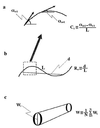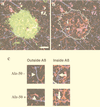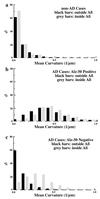Plaque-induced neurite abnormalities: implications for disruption of neural networks in Alzheimer's disease
- PMID: 10220456
- PMCID: PMC21854
- DOI: 10.1073/pnas.96.9.5274
Plaque-induced neurite abnormalities: implications for disruption of neural networks in Alzheimer's disease
Abstract
The brains of Alzheimer's disease patients contain extracellular Abeta amyloid deposits (senile plaques). Although genetic evidence causally links Abeta deposition to the disease, the mechanism by which Abeta disrupts cortical function is unknown. Using triple immunofluorescent confocal microscopy and three-dimensional reconstructions, we found that neuronal processes that cross through an Abeta deposit are likely to have a radically changed morphology. We modeled the electrophysiological effect of this changed morphology and found a predicted delay of several milliseconds over an average plaque. We propose that this type of delay, played out among thousands of plaques throughout neocortical areas, disrupts the precise temporal firing patterns of action potentials, contributing directly to neural system failure and dementia.
Figures




References
-
- Goate A M, Chartier-Harlin C M, Mullan M, Brown J, Crawford F, Fidani L, Giuffra L, Haynes A, Irving N, James L, et al. Nature (London) 1991;349:704–709. - PubMed
-
- Murrell J, Farlow M, Ghetti B, Benson M D. Science. 1991;254:97–99. - PubMed
-
- Chartier-Harlin M-C, Crawford F, Houlden H, Warren A, Hughes D, Fidani L, Goate A, Rossor M, Roques P, Hardy J, et al. Nature (London) 1991;353:844–846. - PubMed
-
- Delaere P, Duyckaerts C, Masters C, Beyreuther F, Piette F, Hauw J J. Neurosci Lett. 1990;116:87–93. - PubMed
-
- Hyman B T, Tanzi R E. Curr Opin Neurol Neurosurg. 1992;5:88–89. - PubMed
Publication types
MeSH terms
Substances
Grants and funding
LinkOut - more resources
Full Text Sources
Medical

